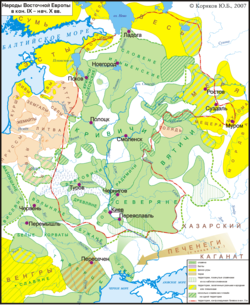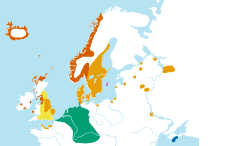

Normanism and anti-Normanism are competing groups of theories about the origin of Kievan Rus' that emerged in the 18th and 19th centuries concerning the narrative of the Viking Age in Eastern Europe. At the centre of the disagreement is the origin of the Varangian Rus', a people who travelled across and settled in Eastern Europe in the 8th and 9th centuries, and are considered by most modern historians to be of Scandinavian origin, eventually assimilated with the Slavs. The Normanist theory has been firmly established as mainstream, and modern Anti-Normanism is viewed as historical revisionism.
The origin of Kievan Rus' is infamously contentious, and relates to its perceived importance for the legitimation of nation-building, imperialism, and independence movements within the East Slavic-speaking world, and for legitimating different political relationships between eastern and western European countries. The Norsemen that ventured from what is now Sweden, into the waterways of Eastern Europe feature prominently in the history of the Baltic states, Scandinavia, Poland, and the Byzantine Empire.[1][2][3][4][5][6][7] They are particularly important in the historiography and cultural history of Belarus, Russia and Ukraine, but have also featured in the history of Poland.[8] Nevertheless, contention has centred around whether the development of Kievan Rus' was influenced by non-Slavic Varangians (this idea is characterised as the "Normanist theory"), or whether the people of Kievan Rus' emerged solely from autochthonous Slavic political development (known as the "anti-Normanist theory"),[9] including some other anti-Normanist and skeptical theories stemming from the scarcity of contemporary evidence for the emergence of Kievan Rus', and the great ethnic diversity and complexity of the wide area where these Norsemen were active.[10]
- ^ Cite error: The named reference
auto1was invoked but never defined (see the help page). - ^ Roman Zakharii,"The Historiography of Normanist and Anti-Normanist theories on the origin of Rus': A review of modern historiography and major sources on Varangian controversy and other Scandinavian concepts of the origins of Rus' Archived 29 December 2022 at the Wayback Machine" (unpublished M.Phil. thesis, University of Oslo, 2002).
- ^ Wladyslaw Duczko, Viking Rus: Studies on the Presence of Scandinavians in Eastern Europe (Leiden: Brill, 2004), pp. 3-9.
- ^ Serhii Plokhy, The Origins of the Slavic Nations Premodern Identities in Russia, Ukraine, and Belarus (Cambridge: Cambridge University Press, 2006), pp. 10-48.
- ^ Christian Raffensperger, "The Place of Rus' in Medieval Europe[permanent dead link]", History Compass, 12/11 (2014), 853–65 doi:10.1111/hic3.12201 (pp. 853-54).
- ^ Elena Melnikova, "The 'Varangian Problem': Science in the Grip of Ideology and Politics", in Russia's Identity in International Relations: Images, Perceptions, Misperceptions, ed. by Ray Taras (Abingdon: Routledge, 2013), pp. 42-52.
- ^ History Time (1 August 2017), Vikings Of The East: Igor & The Kievan Rus', archived from the original on 14 March 2023, retrieved 20 February 2019
- ^ Stephen Velychenko (1992). National History as Cultural Process: A Survey of the Interpretations of Ukraine's Past in Polish, Russian, and Ukrainian Historical Writing from the Earliest Times to 1914. Canadian Institute of Ukrainian Studies Press. pp. 47–49. ISBN 978-0-920862-75-9. Archived from the original on 10 August 2023. Retrieved 27 January 2021.
- ^ Paul Robert Magocsi (18 June 2010). A History of Ukraine: The Land and Its Peoples (Second ed.). University of Toronto Press. pp. 56–58. ISBN 978-1-4426-9879-6. Archived from the original on 10 August 2023. Retrieved 27 January 2021.
- ^ Janet Martin, "The First East Slavic State", in A Companion to Russian History, ed. by Abbott Gleason (Oxford: Blackwell, 2009), pp. 34-50 (pp. 34-36).